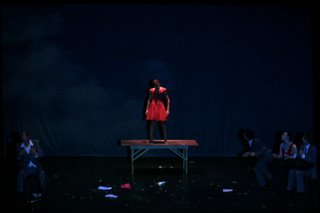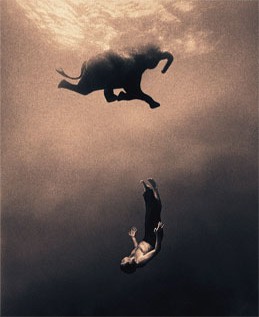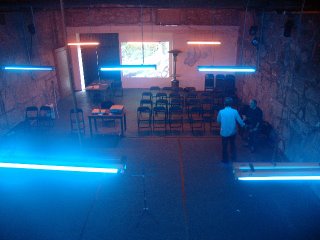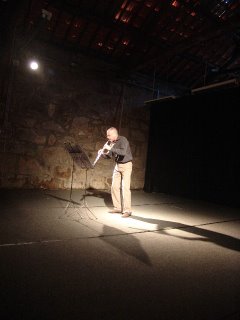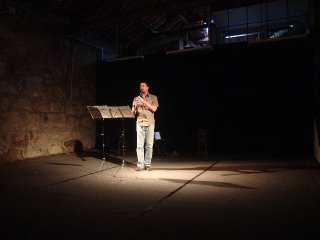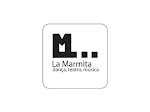Tuesday, April 10, 2007
You need a Stair to Reach to the Stars
“Sure, the whirlwind of inspiration can carry our ‘creative airplane’ above the clouds […] without running down the runaway. The trouble is that these flights do not depend on us and do not constitute the norm. It is within our possibilities to prepare the ground, to lay the rails, that is to say to create the physical actions reinforced by truth and conviction”
These are the words of Stanislavski.
It is very easy to dream to do something profound. It is much more difficult to actually do something profound. An old Russian proverb says, ‘if you go to your porch, look up at the sky, and jump to the stars, you will just land in the mud. Often the stairs are forgotten. The stairs must be constructed. This Grotowski never forgot. One can easily get lost thinking, about the profound metaphysical side of a work, and forget completely the sacrifice and practical labour behind the results.
At Work with Grotowski on Physical Actions by Thomas Richards
Friday, April 06, 2007
Thursday, February 15, 2007
Creativity is a Private Affair

Creativity is a private affair. It is the process of rummaging through and penetrating the intimate world of accumulated memories, thoughts, and sensations down to the very nature of being. If the process of creating does not begin at the source, it stands the danger of becoming a surface experience resulting in a superficial display.
Murray Louis
Speaking about the background of his creative work Aaron Copland wrote:
“What, after all do I put down when I put down notes? I put down a reflection of emotional states; feelings, perceptions, imagining, intuitions. An emotional state, as I use the term, is compounded of everything we are: our background, our environment, our convictions. Art particularizes and makes actual these fluent emotional states. Because it particularizes and makes it actual, it gives meaning to ‘la condition humaine’.
Thursday, February 08, 2007
A World of Images

Whenever we begin to work or to attend to something we have made or collected, a world of images opens up before us. As we move or make, write or speak, we bring in to existence the stories of that world. As we work we may feel we are at the edge of some story that we do not know, or moving in and out of different stories whose shapes we cannot quiet see. And as we continue to work and to respond to what we have made, these fragments may begin to cohere as clusters of images or loose narratives. These are not necessarily stories in words, nor are they generally the conventional type of story with a narrative line, a beginning and an end. But as we work we begin to get a sense of an emergent world with its own elements, its own way of coming together.
From A Widening Field. Journeys in Body and Imagination by Miranda Tufnell and Chris Crickmay
Saturday, January 27, 2007
Simple Ideas with Imagination
The project I am working is based in my father's material. I never wanted to do it, because I feel is a big responsability to represent his incredible imaginative world of songs and stories. The challenge is not to re-create what has already being done, but to use my own imagination as well, I am sure he would have asked this from me.
The most difficult to do when working for a so young public, is that ideas have to be simple and extremelly imaginative. This was the strength of my father's work, a strenght we also find in the work of Jim Henson
Tuesday, January 23, 2007
Choreographic Transformation

Heaven 2 is the result of a choreographic transformation, a process that began with Heaven in March of 2006, as result of the adaptation of an earlier choreography called The Guests.
The Guests was premiered in the year 2000 in Porto. The cast was constituted by seven dancers and three extras. The research period had taken eight months and the rehearsal period two months. When I arrived to the studio I worked most of the time as what Jo Butterworth calls the “Choreographer as an expert”, this means I had absolute control over the concept, style and structure of the piece, guiding at the same time the performers in their interpretation (2004: 55).
Unfortunately we just had two performances and it was impossible to tour with it because the large cast made the piece expensive for travelling.
When I was invited to make a co-production this year with the Festival Arena in Erlangen, Germany, I was eager to make a new version of this choreography, this time for actors. The core of the theme stayed the same; I kept my favourite scenes and created new ones. The result was a completely new piece and my approach as a choreographer was more as an author at times, which means that I had the whole control of the piece but “in relation to capabilities and qualities of the performers” (Butterworth 2004: 55).
I took the original “script” and applied it to a more concrete situation. Four business men arrive to a dinner without knowing who had sent the invitation or why they were invited. They have never seen each other before and a clear power game develops between them. I maintained the figure of the butler, not as a representation of death, but of change- a kind of devil of transformation.
The choice of making a new adaptation of this choreography for my Masters course came from the interest of exploring the piece with dancers; my intent was to maintain the theme of the piece intact as well as most of the frame of the scenes and to develop its language into dance movement. My aim was to explore if this approach enriches or not a choreography that had been done for actors. I wanted to change my approach as a choreographer, letting much more freedom to the dancers for their interpretation and suggestions, which would make me according to Butterworth’s word a “choreographer as a pilot”, where there is an “active participation from both parties” (2004:55).
As far as the general expressive character of the piece, I maintained it as if it were a silent movie. This means exaggerating the facial expressions and playing with surreal pauses or tempos, something that had been done already in the German Expressionist Theatre.
"For the actors of Expressionist theatre, the issue was not only linguistic sensitivity to the text but also physical sensitivity to the plastic rhythms of the performance space. Movement and vocalization took on and became part of the total poetic form that constituted the staging of Expressionism’s sometimes symbolic, sometimes allegorical, but never realistic dramatic world".
(Kuhns 19997: 92)
During the sixties and seventies, avant-garde choreographers tended to reject theatre and narrative elements. By doing this they were placing themselves away from ballet and modern dance. In recent years, “post-modern dance has moved from denying theatricality to embracing it” (Banes 1994: 252). I have been experimenting with theatre now for many years, not just in choreographies done for dancers, but combining different kind of performers such as musicians, singers and actors. If someone would ask me how I would label my choreographies, then I would say they are “post-modern”.
Although Heaven 2 is not innovative, it has an individual signature and is a personal exploration. While the amount of time of rehearsals was too short for what I would have liked to achieve with professional dancers, nevertheless I am able to see the potential that this piece could have with more movement.
I thank all my marvelous colleagues for their great input and interpretation. You guys made this project possible, a miracle in so short time! Love you
Francisco Pedro
Sveinborg Porhalld
Keith-Derek Randolph
Joshua Trebi
Aphrodite Vervenioti
Banes, Sally (1994) Writing Dancing in the Age of Postmodernism,
USA: Wesleyan University Press
Barba, Eugenio (1991[1999]) A Dictionary of Theatre Anthropology,
London: Routledge
Butterworth, Jo (2004) Research in Dance Education. Vol 5, nº1,
ISSN 1464-7893 (print)
UK: Taylor & Francis Ltd
Kuhns, David (1997) German Expressionist Theatre. The actor and the stage,
UK: Cambridge University Press
Friday, January 05, 2007
Ballet Mecanique
I am finding some really interesting videos in the Internet, I would like to share with you. I post this one by Ferdinand Legers, Ballet Mecanique
You can find more information about this film at:
http://www.antheil.org/film.html
Thursday, January 04, 2007
Transforming
I love this video, it reflects the transformation of the idea, the way the mind composes, chooses and arranges, to create something new from the old, a new interpretation a new view.
It makes me think about the way I create my own scripts for choreographies. They all begin with the research of the idea. Many times the idea comes from a book, or a photograph, or painting. Sometimes the idea comes from a situation real or imagined. Once I know the theme I want to develop, I research as if I were going to write an essay, taking notes while I read. The material I find is always related to ideas of light, movement, characters, and costumes and so on, anything that can help me build the choreography. Many times it takes many pages of notes, others I resolve the theme in a very short time, with less research. Personally I always need a research period, so I can find what I call the heart of the choreography or dramaturgy, as Eugenio Barba writes:
The word text, before referring to a written or spoken, printed or manuscripted text, meant ‘a weaving together’. In this sense there is no performance that has no ‘text’.
That which concerns the text (the weave) of the performance can be defined as ‘dramaturgy’, that is, drama-ergon, ‘the ‘work of the actions’ in the performance. The way in which the actions work is a plot.
(1999: 68)
Saturday, December 30, 2006
Heaven Pictures 1
Choreography:Andrea Gabilondo; Music: Bach- Beethoven- Gergely Suto- Irving Berlin Kroke-Schubert, Sapo Perapaskero, TNX; Light Design: Rui Damas; Video:Luis Miguel Sousa; Props and Costumes: Susanne Rösler; Production Assistents: Claudia Wolf and Christina Zimmerman, Cast: Elsa Pierry-Grammare, Freddy Trinidad,Martin Mühlenweg, Nardo Vogt and Viriato Morais
Co-production: Festival Arena e La Marmita
Apoios:
Câmara Municipal de Gaia
MC- Ministério de Cultura- IA- Instituto das Artes
Festival Arena
Pé de Vento
Teatro Helena Sá e Costa
Dois Pontos- Associação Cultural
Ghostly Table
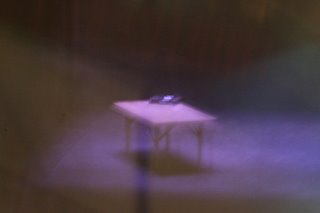
Practical ways of setting a table cloth. Viriato Morais and Freddy Trinidad

To the left? To the right? Freddy Trinidad

The fork is dirty. Viriato Morais and Nardo Vogt

At the table. Elsa Pierry-Grammare, Martin Mühlenweg, Nardo Vogt and Freddy Trinidad

Some wine? Viriato Morais and Martin Mühlenweg
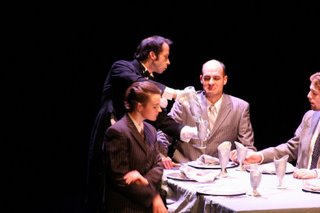
Heaven Pictures 2
Sunday, December 03, 2006
Heaven apresenta-se no Porto

Os dias 11, 12, 13, 14 e 15, organizamos espectáculos para o publico escolar.
Os dias 15 e 16 espectáculos às 21.30 para publico em geral., no Espaço de ensaios de La Marmita. Rua de França 6 na Ribeira Gaia perto do Sandemans.
Nos dias 21 e 22, espectáculos no Teatro Helena Sá e Costa no Porto, Rua de Alegria com esquina na Rua da Normal Superior.
Heaven
Reflectindo ironicamente temas como a morte e convenções humanas que escravizam os seres humanos, a acção de Heaven decorre num espaço intemporal onde as personagens, executivos de sucesso, se encontram presentes para um elegante jantar.
Seis intérpretes dão corpo às personagens que revelam uma alta auto-estima, num universo de ilusões que vai ruindo à medida que são confrontados com a sua fragilidade existencial.
A coreografia recolhe elementos expressionistas, fundindo movimentos contrastantes e denunciando a futilidade e superficialidade de um mundo em que as aparências se revelam superiores à realidade.
Concepção e Coreografia
Andrea Gabilondo
Música
Bach- Beethoven- Gergely Suto- Irving Berlin Kroke-Schubert, Sapo Perapaskero, TNX
Realização de Vídeo
Luis Miguel Sousa
Desenho de Luz
Rui Damas
Espaço cénico e figurinos
Susanne Rösler
Assistente de Produção
Claudia Wolf- Christine Zimmerman
Intérpretes
Elsa Pierry-Grammare
Freddy Trinidad
Martin Mühlenweg
Nardo Vogt
Viriato Morais
Co-produção: Festival Arena e La Marmita
Apoios:
Câmara Municipal de Gaia
MC- Ministério de Cultura- IA- Instituto das Artes
Festival Arena
Pé de Vento
THSC
Saturday, November 04, 2006
Tour to Mexico
 Glass on the ceiling of the Teatro de Bellas Artes.
Glass on the ceiling of the Teatro de Bellas Artes. We just came back from Mexico.
We had eight performances in the City and in Mazatlan, Culiacan and Los Mochis. Unfortunatelyey three tours were cancelled due to the unstable political situation, so in the middle of these long five weeks, we had many free days.
 Eagle found in the excavations of the Templo Mayor
Eagle found in the excavations of the Templo MayorNevertheless it was a positive experience to bring my work after 20 years of absence in the professional field.
On the other hand, to make contact with many friends after all these years in Europe,was a highly emotional experience.
 In Valle de Bravo with actor Viriato Morais and my beloved Rene, widow of my mother
In Valle de Bravo with actor Viriato Morais and my beloved Rene, widow of my motherMexico explosive as ever, chaotic, but its people warm and with an open heart.
I thank all of you that made this trip possible.
 Of course tequila is a must! Light designer Rui Damas and actor Viriato Morais
Of course tequila is a must! Light designer Rui Damas and actor Viriato MoraisTuesday, September 26, 2006
For Three Months
But not so the projects that seem to duplicate and the Masters in Choreography in between heavy periods of rehearsals and performances.

Heaven was well recieved in Germany and then in Porto where we performed in the Festival Set.

We travel tomorrow with "Afternoon Soap" to a whole month tour in Mexico.
Then a production project with the University of Performing Arts in Porto.
And in December, "Heaven" again in Porto with performances in the space of "La Marmita" and the Theatre Helena Sá e Costa.
I love my work, but I miss my quiet moments.

Wednesday, June 28, 2006
Last two weeks of rehearsals

We have being here rehearsing for almost two weeks, interrupted by some inevitable football games. As usual the hospitality of Arena and of the city of Erlangen are wonderful. I add to this the wonderful work atmosphere of all the team.
Opening night 8th of July at 19H in the "Experimentier Theatre"- Erlangen
Wednesday, June 07, 2006
Ciclo de Concertos- Junho e Julho
Espaço La Marmita
Rua da França 6 - Ribeira de Gaia

JUNHO
Sábado 10 às 21H
Música electrónica
Eugene Kovax
Sábado 17 às 19H
Musica clássica e contemporânea
Obras de Telemann, Villa Lobos e Ellen Burr
Ellen Burr- flauta
Steve Burr- Percussão
Robert Glassburner- Fagote
Sábado 25 às 21H
Música electrónica
Stephane Blok
Quinta-feira 29 às 21H
Música electrónica
Stephane Blok- Eugene Kovax
JULHO
Sábado 1 às 19HRecital de violoncelo solo
Obras de Bach, Crumb e Cassadó
Bruno Cardoso- violoncelo
Sábado 8 às 21H
Rock contemporâneo português
Elfland
Sábado 15 às 22H
Música clássica do século XX
Obras de Jolivet e Villa Lobos
Aldo Salvetti- oboé
Robert Glassburner- fagote
Domingo 16 às 19H
Música clássica do século XX
Obras de Jolivet e Villa Lobos
Aldo Salvetti- oboé
Robert Glassburner- fagote
Sábado 22 às 19H
Confronto com o contemporâneo
Tilike Coelho- percussão
Robert Glassburner- fagote
Entrada: 5 euros
Tuesday, June 06, 2006
10 de Junho- Música Electrónica
Rua de França, 6 - Ribera de Gaia ☞`
Pelas 21H
Musica Electrónica
Eugene Kovax

“Eugene kovax” iniciou-se na primavera de 2004 como projecto de improvisação livre e informatizado dos húngaros Zoltan Santa e Gergely Suto, Violonista e Clarinetista da Orquestra
Nacional do Porto. Entretanto também se tornou no projecto a solo de Gergely, sendo o violino então substituído por um controlador MIDI a sopro, ou por vezes,
por um clarinete. Equipado ainda com um baixo eléctrico, e um laptop, Gergely arrisca-se a uma performance entre Homem-Orquestra e DJ-Act em que a principal intenção é conseguir infil trar uma música electrónica com ideias espontâneas de improvisação.
Gergely Süto nasceu em Budapeste, Hungria, em 1972. Começou a estudar clarinete aos dez anos de idade. Em 1992, obteve o diploma de solista na classe de Robert Kemblinsky, no Conservatoire de Lausanne, Suiça. Posteriormente, especializou-se em clarinete baixo com Jean-Marc Volta, em Paris. Recebeu vários prémios em concursos nacionais suíços e em 1992 ganhou o 2° prémio no Concours International de Sonates de Vierzon (França), com o pianista Cédric Pescia. A partir de 1993, foi instrumentista convidado da Orchestre de Chambre de Lausanne e durante a temporada 1995-96, foi convidado para o lugar de 1° clarinete na Orchestre Symphonique de Bienne, Suiça. Em 1997, numa primeira incursão em Portugal, colaborou como segundo clarinete na Orquestra Gulbenkian, Lisboa. Entre 1998 e 2000, actuou com a Filarmonia Nacional da Hungria. Desde 2000, é músico da Orquestra Nacional do Porto. Para além da carreira de música clássica, Gergely Süto tem desenvolvido actividades musicais paralelas no âmbito da composição, improvisação e música electrónica.
Saturday, May 13, 2006
Adeus Querido Rui Lima
Wednesday, April 05, 2006
Pictures of the Concert
Sunday, March 26, 2006
Música Contemporânea e Mostra de Vídeo
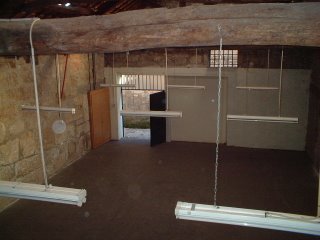
Concerto de Musica Contemporânea e Mostra de Vídeo Arte
Sábado 1 e Domingo 2 de Abril às 16.30H
Rua de França 6 – Perto do Sandemans em Vila Nova de Gaia
Coreografia de teatro-musical para um fagotista

Coreografia: Andrea Gabilondo , baseada na partitura de “Atem” de Maurício Kagel
Interpretação: Robert Glassburner
Gravação em estudo: Robert Glassburner e Tilike Coelho
Mauricio Kagel escreveu para a estreia de Atem no Curso Internacional de Nova Música em Darmstad em 26 de Agosto de 1970: “ Um dos meus vizinhos é um instrumentista de sopros aposentado. A sua actividade principal nestes dias é a de preparar palhetas para os colegas. Para verificar a qualidade das palhetas, ele sempre toca a mesma curta sequência de notas ( floreado/ rápido/ floreado/ pausa/ floreado).
O filho do velhote também mora na mesma casa, é trinta anos mais jovem e também é músico. Toca o trombone.”
A partir de aqui Kagel cria Atem, uma composição para um instrumentista de sopros a solo e gravação de efeitos de som na qual se desenvolve uma cena: um músico entra, senta-se e toca. As notas que tenta tocar, poucas vezes saem limpas provocando um monólogo interior onde o texto consiste em sons em vez de palavras. Nesta evocação da visão do teatro de Samuel Becket, o músico envelhece, e ao final incapaz de tocar sem distorção, morre...
A coreografia baseia-se nesta partitura, tomando liberdades teatrais e de movimento; todos os elementos da peça musical estão presentes mas elaborados de outra forma, sendo explorados através da linguagem de Dança-Teatro e restrito cenicamente a um mundo geométrico ao nível da luz.
Robert Glassburner
Natural dos Estados Unidos, estudou na Wichita State University com Michael Dicker e Dennis Michel, com Harold Goltzer da Filarmónica de Nova Iorque e com Arthur Weisberg na Yale School of Music.
Foi fagotista solista na Connecticut Philarmonic, Orquesta Sinfónica de Maracaibo, Venezuela, Ópera do Teatro de Bellas Artes-Cidade do México, no Teatro S. Carlos-Lisboa, e foi associado com a Limburgs Symphonie Orkest- Maastricht, o Ensemble Ad Libitum-Maastricht, a Orquesta Sinfónica de Galicia, e a Radio Filharmonisch Orkest-Hilversum. Foi artista convidado no Orlando Festival (Holanda), 1992.
Foi premiado na National Collegiate Solo Competition e no Concours International de l’UFAM ( Paris).
Desde 1995 é professor de fagote e música de câmara no Conservatório de Música do Porto e na Escola Profissional de Espinho.
Em 1993 ingressa na Orquestra Nacional do Porto onde toca actualmente como
solista A

Música: Luciano Berio
Aldo Salvetti, Oboé
Notas do compositor:
“O teu perfil é a minha paisagem frenética, segurada à distância
É um fogo de amor falso, que é insignificante: é morto”
Sequenza VII é habitada duma espécie de conflito permanente – para mim muito expressivo e as vezes dramático – entre a velocidade extrema da articulação instrumental e a lentidão do processo musical que sustenta o percurso da obra: por exemplo ter uma certa imobilidade dos registros, uma prolongada ausência de algumas notas e a gradual invasão de certos intervalos, (como a quinta perfeita, por exemplo, que faz lembrar o famoso solo de corno inglês da ópera “Tristan e Isolde” de Wagner).
Com a Sequenza VII (como com as Sequenzas para flauta, tromba, clarinete, trombone e fagote) prossegue-se a minha pesquisa duma polifonia virtual. Nesta Sequenza, a parte solista é colocado em perspectiva, se fosse analisado pela presencia constante de uma “tónica”, um Si natural, que podia ser tocado em pianíssimo por qualquer instrumento fora do palco.
Sequenza VII foi escrito em 1969 para o oboista Heinz Holliger.
Aldo Salvetti
Nasceu em Veneza, onde aos 20 anos començou o estudo do oboé con Giorgio Trentin.
Em 1987 diplomou-se no Conservatório de Música "Giuseppe Verdi" de Milão, na classe de Giacomo Calderoni.
Concluiu o Curso de Licenciatura em Basileia e em Zurique, com Emanuel Abbhül e Thomas Indermühle.
Integrou a Orquestra Nacional da Academia de Santa Cecilia em Roma, e colaborou regularmente com a Symphonisches Orchester Zürich e a Basel Sinfonietta.
Foi Primeiro Oboé da Orchestra Sinfonica Siciliana e Chefe de Naipe dos Oboés da Vogtland Philharmonie Greiz-Reichenbach.
Desde 1996 reside em Portugal, onde foi Primeiro Oboé da Orquestra Clássica do Porto e, actualmente, è Chefe de Naipe da Orquestra Nacional do Porto.
Colabora regularmente, desde a sua criação em 2001, com a OrchestrUtópica.
Desde 1997 è professor de Oboé e Música de Conjunto na Escola Profissional de Música de Espinho.
È docente da Licenciatura em Música da Universidade Católica Portuguesa, no Porto, e do Istituto Piaget, Campus Universitário de Almada.
New York Counterpoint
Concerto para clarinete de música minimalista
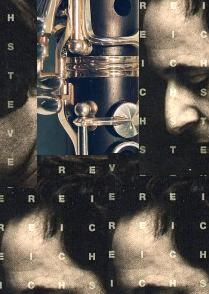
Música: Steve Reich
Gergely Süto, clarinete solo e clarinetes pré-gravados
Notas do compositor:
“New York Counterpoint” foi escrito em 1985, como encomenda da Fundação Fromm para o clarinetista Richard Stoltzman.
A obra segue uma ideia já utilizada em Vermont Counterpoint (1982) onde um solista interage com uma gravação previamente feita pelo mesmo intérprete. No caso de New York Counterpoint, a gravação consiste de dez vozes de clarinete e clarinete baixo com a décima primeira voz tocada ao vivo em cima da gravação.
A peça tem três andamentos: rápido, lento, rápido, que se tocam seguidamente e sem pausa. O compasso da peça é 3/2 = 6/4 (=12/8), com as mudanças de tempo em relações proporcionais simples. Especialmente no terceiro andamento Reich aproveita as ambiguidades rítmicas desta batuta, juntando três grupos de quatro ou quatro grupos de três notas, marcando a diferença só pela mudança da
acentuação.
Gergely Süto
Gergely Süto nasceu em Budapeste, Hungria, em 1972. Começou a estudar clarinete aos dez anos de idade. Em 1992, obteve o diploma de solista na classe de Robert Kemblinsky, no Conservatoire de Lausanne, Suiça. Posteriormente, especializou-se em clarinete baixo com Jean-Marc Volta, em Paris. Recebeu vários prémios em concursos nacionais suíços e em 1992 ganhou o 2° prémio no Concours International de Sonates de Vierzon (França), com o pianista Cédric Pescia. A partir de 1993, foi instrumentista convidado da Orchestre de Chambre de Lausanne e durante a temporada 1995-96, foi convidado para o lugar de 1° clarinete na Orchestre Symphonique de Bienne, Suiça. Em 1997, numa primeira incursão em Portugal, colaborou como segundo clarinete na Orquestra Gulbenkian, Lisboa. Entre 1998 e 2000, actuou com a Filarmonia Nacional da Hungria. Desde 2000, é músico da Orquestra Nacional do Porto. Para além da carreira de música clássica, Gergely Süto tem desenvolvido actividades musicais paralelas no âmbito da composição, improvisação e música electrónica.
Vídeo
Noelle Greorg, Carlos Carrilho e Antje Feger/Benjamin Florian Stumpf
Organização: Claudia Mel
"Em quantas coisas que me emprestaram eu sigo no mundo. Quantas coisas que me emprestaram guio como minhas!" Álvaro de Campos
Ocupar um espaço, na cidade, na cultura.
Encontrar um lugar e fazê-lo próprio, pátilhar-lo com os outros... produzir, criar. Os recursos estão à volta. Deixar marcas.
Noelle Greorg
La rue est a nous
A rua e nossa e um film sobre a occupacao do espaco publico. E o latin squat
mini dv, cores, som 2min46, 2005
Carlos Carrilho
I Belong
video, p/b, som, 07'50", 2005
Esperrei tanto tempo. Foi isto que vim, de tao longe, procurar? Sinto que algo me observa, aguardando por mim. Mas não fugirei. Que engraçado! Tudo isto é tão feio e no entanto tão confortavel! Nunca, nunca mais quero sair de aqui.
Antje Feger/Benjamin Florian Stumpf
Video, cor, 04'59'', 2005
trafic-time-space/us in between/non stop-stop
Este evento está inserido dentro da programação, "Gaia ConVida", uma iniciativa da Câmara Municipal de Gaia.
Apoios:
Câmara Municipal de Gaia
Dois Pontos- Associação Cultural
Pé de Vento
Teatro Helena Sá e Costa
Produção: La Marmita
Monday, March 20, 2006
Heaven- Rehearsals 2


Rich in imagery and symbolism, the characters of the dance-theatre piece Heaven, are caught in a timeless, absurd and ecstatic world.
The characters are unaware who invited them to this elegant dinner and for what motive. We see at first confident business men preparing for an important meeting that will slowly transform itself into the site of existential enquiry as they drop their self-assured masks.
There is an overall extreme austerity that envelops the choreography broken by moments of colourful irony.
Video projections, mostly in black and white, using the techniques of close-up and fragmentation of the performer’s image on stage, give the chilling effect of an uninvited ghost.
The choreography makes use of elements of the Expressionist Theatre, blending sharp contrasting movements with motionless continence.
The voice is used sparingly, often as a dehumanized sound, as a portrayal of the mood and mental state of the characters, providing scenes of grotesque beauty.
Heaven is an ironic meditation on death and about our absurd conventions that hold us as slaves to our inner selves.






